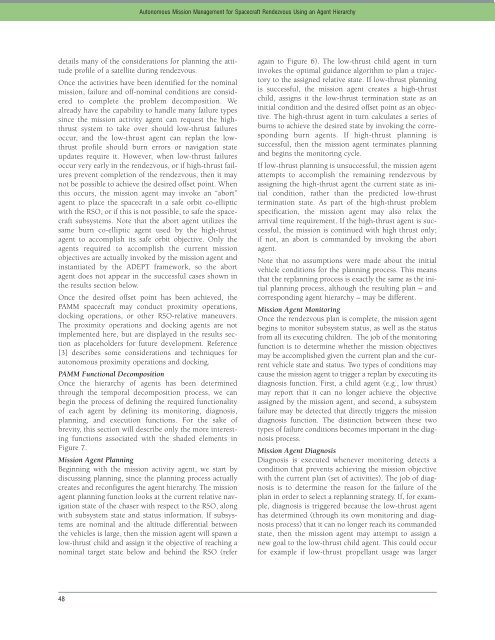TECHNOLOGY DIGEST - Draper Laboratory
TECHNOLOGY DIGEST - Draper Laboratory
TECHNOLOGY DIGEST - Draper Laboratory
Create successful ePaper yourself
Turn your PDF publications into a flip-book with our unique Google optimized e-Paper software.
details many of the considerations for planning the attitude<br />
profile of a satellite during rendezvous.<br />
Once the activities have been identified for the nominal<br />
mission, failure and off-nominal conditions are considered<br />
to complete the problem decomposition. We<br />
already have the capability to handle many failure types<br />
since the mission activity agent can request the highthrust<br />
system to take over should low-thrust failures<br />
occur, and the low-thrust agent can replan the lowthrust<br />
profile should burn errors or navigation state<br />
updates require it. However, when low-thrust failures<br />
occur very early in the rendezvous, or if high-thrust failures<br />
prevent completion of the rendezvous, then it may<br />
not be possible to achieve the desired offset point. When<br />
this occurs, the mission agent may invoke an “abort”<br />
agent to place the spacecraft in a safe orbit co-elliptic<br />
with the RSO, or if this is not possible, to safe the spacecraft<br />
subsystems. Note that the abort agent utilizes the<br />
same burn co-elliptic agent used by the high-thrust<br />
agent to accomplish its safe orbit objective. Only the<br />
agents required to accomplish the current mission<br />
objectives are actually invoked by the mission agent and<br />
instantiated by the ADEPT framework, so the abort<br />
agent does not appear in the successful cases shown in<br />
the results section below.<br />
Once the desired offset point has been achieved, the<br />
PAMM spacecraft may conduct proximity operations,<br />
docking operations, or other RSO-relative maneuvers.<br />
The proximity operations and docking agents are not<br />
implemented here, but are displayed in the results section<br />
as placeholders for future development. Reference<br />
[3] describes some considerations and techniques for<br />
autonomous proximity operations and docking.<br />
PAMM Functional Decomposition<br />
Once the hierarchy of agents has been determined<br />
through the temporal decomposition process, we can<br />
begin the process of defining the required functionality<br />
of each agent by defining its monitoring, diagnosis,<br />
planning, and execution functions. For the sake of<br />
brevity, this section will describe only the more interesting<br />
functions associated with the shaded elements in<br />
Figure 7.<br />
Mission Agent Planning<br />
Beginning with the mission activity agent, we start by<br />
discussing planning, since the planning process actually<br />
creates and reconfigures the agent hierarchy. The mission<br />
agent planning function looks at the current relative navigation<br />
state of the chaser with respect to the RSO, along<br />
with subsystem state and status information. If subsystems<br />
are nominal and the altitude differential between<br />
the vehicles is large, then the mission agent will spawn a<br />
low-thrust child and assign it the objective of reaching a<br />
nominal target state below and behind the RSO (refer<br />
48<br />
Autonomous Mission Management for Spacecraft Rendezvous Using an Agent Hierarchy<br />
again to Figure 6). The low-thrust child agent in turn<br />
invokes the optimal guidance algorithm to plan a trajectory<br />
to the assigned relative state. If low-thrust planning<br />
is successful, the mission agent creates a high-thrust<br />
child, assigns it the low-thrust termination state as an<br />
initial condition and the desired offset point as an objective.<br />
The high-thrust agent in turn calculates a series of<br />
burns to achieve the desired state by invoking the corresponding<br />
burn agents. If high-thrust planning is<br />
successful, then the mission agent terminates planning<br />
and begins the monitoring cycle.<br />
If low-thrust planning is unsuccessful, the mission agent<br />
attempts to accomplish the remaining rendezvous by<br />
assigning the high-thrust agent the current state as initial<br />
condition, rather than the predicted low-thrust<br />
termination state. As part of the high-thrust problem<br />
specification, the mission agent may also relax the<br />
arrival time requirement. If the high-thrust agent is successful,<br />
the mission is continued with high thrust only;<br />
if not, an abort is commanded by invoking the abort<br />
agent.<br />
Note that no assumptions were made about the initial<br />
vehicle conditions for the planning process. This means<br />
that the replanning process is exactly the same as the initial<br />
planning process, although the resulting plan – and<br />
corresponding agent hierarchy – may be different.<br />
Mission Agent Monitoring<br />
Once the rendezvous plan is complete, the mission agent<br />
begins to monitor subsystem status, as well as the status<br />
from all its executing children. The job of the monitoring<br />
function is to determine whether the mission objectives<br />
may be accomplished given the current plan and the current<br />
vehicle state and status. Two types of conditions may<br />
cause the mission agent to trigger a replan by executing its<br />
diagnosis function. First, a child agent (e.g., low thrust)<br />
may report that it can no longer achieve the objective<br />
assigned by the mission agent, and second, a subsystem<br />
failure may be detected that directly triggers the mission<br />
diagnosis function. The distinction between these two<br />
types of failure conditions becomes important in the diagnosis<br />
process.<br />
Mission Agent Diagnosis<br />
Diagnosis is executed whenever monitoring detects a<br />
condition that prevents achieving the mission objective<br />
with the current plan (set of activities). The job of diagnosis<br />
is to determine the reason for the failure of the<br />
plan in order to select a replanning strategy. If, for example,<br />
diagnosis is triggered because the low-thrust agent<br />
has determined (through its own monitoring and diagnosis<br />
process) that it can no longer reach its commanded<br />
state, then the mission agent may attempt to assign a<br />
new goal to the low-thrust child agent. This could occur<br />
for example if low-thrust propellant usage was larger

















